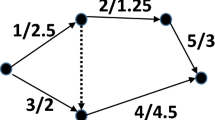Abstract
In this paper, we present a useful bicriteria model for analyzing the time–cost tradeoffs that can be achieved when undertaking a project consisting of a single task. Some related mathematical results are also presented. The model assumes that several different processes may be used to undertake the task, defining different operating modes, and also assuming that managers may change the process in use after the task is started, depending on the way the task is developing. The model is easy to use, and it can be applied to a large number of real-life situations when the objectives are to minimize cost and time. We present some ideas for an algorithm aimed at identifying sets of relevant strategies from which the decision-maker may choose a suitable strategy. We also present several mathematical properties that may be useful for such an algorithm.



Similar content being viewed by others
Notes
It may sometimes be the case that early decisions or events will influence the project advance much later. In such cases, the Markovian assumption does not hold, and the probabilities must depend on the complete history.
In many cases, the aforementioned assumptions may not hold (small firms or public projects, for instance), and it may not be advisable to assume cost risk-neutrality. In such cases, an approach similar to the one used for time aggregation (presented below) may be used. The use of such approach would not cause any significant changes in the results presented in this paper.
It may be argued that we should also address the time-value of money in the aggregation of cost. However, if we assume that the project time-span is short, or that the rate of cost increase is approximately equal to the discount rate, the present value of the project cost will be similar to the expected project cost.
In Eq. 8 we used \( T_{p} {\left( {s^{ - } ,{\left( {P_{i} ,a_{i} } \right)}} \right)}\,{\text{and}}\,T_{p} {\left( {s^{ + } ,{\left( {P_{i} ,a_{i} + b_{i} } \right)}} \right)}. \) Notice that Eq. 8 refers to the complete strategy, so the previous history is ψ = ∅. This means that \(T_{p} {\left( {s^{ - } ,{\left( {P_{i} ,a_{i} } \right)}} \right)} = T_{p} {\left( {s^{ - } ,\psi ^{ - }_{i} } \right)}\) and \(T_{p} {\left( {s^{ - } ,{\left( {P_{i} ,a_{i} } \right)}} \right)} = T_{p} {\left( {s^{ - } ,\psi ^{ - }_{i} } \right)}\), and that we can use \(T_{p} {\left( {s^{ - } ,\psi ^{ - }_{i} } \right)}\) and \(T_{p} {\left( {s^{ + } ,\psi ^{ + }_{i} } \right)}\) when referring to the aggregate times of the partial strategies in Eq. 8.
The proof (as well as the proofs of the other mathematical results) can be obtained from the authors upon request.
We assume that if a partial strategy s p1 is eliminated because of the existence of another partial strategy s p2, then s p2 is not eliminated because of the existence of s p1. This can be achieved by performing any ordering of the partial strategies and assuming that a strategy s p1 may only be eliminated if it is strictly dominated or if Eqs. 12 and 13 hold for a strategy s p2 positioned before s p1.
References
Friedl G (2002) Sequential investment and time to build. Schmalenbach Business Review 54:56–79
Godinho PC (2003) Using bicriteria decision trees in project analysis (in Portuguese). Ph.D. Thesis, Faculty of Economics of the University of Coimbra
Godinho PC, Costa JP (2002) A note on the use of bicriteria decision trees in capital budgeting. Glob Bus Econ Rev 4(1):147–158
Godinho PC, Costa JP (2004) The use of cost and time in project decision trees: a model and an application. Notas Econ 20:145–161
Gutjahr WJ, Strauss C, Wagner E (2000) A stochastic branch-and-bound approach to activity crashing in project management. INFORMS J Comput 12(2):125–135
Herroelen W, Leus R (2005) Project scheduling under uncertainty: survey and research potentials. Eur J Oper Res 165:289–306
Laslo Z (2003) Activity time–cost tradeoffs under time and cost chance constraints. Comput Ind Eng 44:365–384
Mulvey JM, Ziemba WT (1995) Asset and liability allocation in a global environment. In: Jarrow RA, Maksimovic V, Ziemba WT (eds) Handbooks in operations research and management science, vol 9. Finance, North-Holland, pp 435–463
Majd S, Pindyck R (1987) Time to build, option value and investment decisions. J Financ Econ 18:7–27
Pindyck R (1993) Investments of uncertain cost. J Financ Econ 34:53–76
Trigeorgis L (1993) The nature of option interactions and the valuation of investments with multiple real options. J Financ Quant Anal 28(1):1–20
Tsekrekos AE (2001) Investment under economic and implementation uncertainty. R&D Management 31(2):127–135
Acknowledgements
We are grateful for the insightful suggestions of an anonymous referee. This work was supported by ‘Fundação para a Ciência e Tecnologia’ and FEDER, project POCTI/EGE/58828/2004.
Author information
Authors and Affiliations
Corresponding author
Rights and permissions
About this article
Cite this article
Godinho, P.C., Costa, J.P. A stochastic multimode model for time–cost tradeoffs under management flexibility. OR Spectrum 29, 311–334 (2007). https://doi.org/10.1007/s00291-006-0037-4
Published:
Issue Date:
DOI: https://doi.org/10.1007/s00291-006-0037-4




